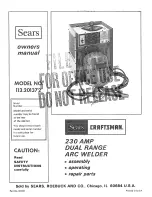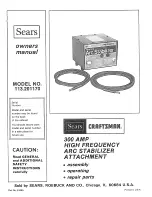
Inspect before using the pulley.
Using the product when there is a problem accelerates the
damage and may lead to strength deterioration, damage
to the product, or an accident of falling hoisted load.
Inspection and maintenance
In case of trouble
Remove the nut using a socket wrench.
* Use adhesive agent that is sticky.
(Loctite 271 is recommended)
When detaching the nut, and then attaching the nut again, apply
adhesive agent to the screw of the nut.
●
The sheave pin and the becket bolt are subject to the caulking
operation to prevent looseness.
Socket
Swivel
Body
Sheave pin
●
Sheave pin
Sheave
●
Sheave
●
Sheave pin
●
Becket pin
●
Becket
●
Caulking jig
●
Becket
●
Sheave
●
Sheave pin
●
Sheave
Bearing
Nut
Sheave pin
Sheave pin nut
Becket bolt
Caulking jig
(Sold separately)
Hexagon socket wrench
Size
50
75
100
Double face
width of nut 14mm
22mm
24mm
[Replacement parts]
Inspection before use
Warning
In the unlikely event the pulley deforms or breaks and
a load is hanging in midair, first take down the hoisted
load, unload the pulley, and take safety measures to
prevent secondary disaster.
Warning
Do not use products that are in the following conditions.
·
Products that are deformed, cracked, or worn out
·
Products with signs of corrosion such as rust
stains or galvanic corrosion
Doing so may lead to serious injury or a fatal accident
due to falls or falling hoisted loads.
Do not let the product touch other types of metal
for long periods of time.
Doing so will cause corrosion.
Warning
Be sure to apply adhesive agent.
If adhesive agent is not applied, the nut will come
off and the sheave will fall, leading to accident.
Warning
Do not scrape the body.
Since the body becomes unusable when it is
scraped, do not scrape any more once the
caulking part of the becket bolt is removed.
Caution
Be sure to perform caulking operation. Also be
sure to check that the nut does not become
loose after performing caulking operation.
If not fully caulked, the nut will come off and the
sheave will fall and lead to accident.
Warning
Be sure to perform caulking operation. Also be
sure to check that the nut and bolt do not become
loose after performing caulking operation.
If not fully caulked, the nut or bolt will come off
and the sheave will fall, leading to accident.
Warning
Caution
Caution
●
The sheave pin nut and the becket pin nut are subject to the caulking
operation to prevent looseness.
<Inspection of movable parts>
<Nut inspection>
●
The swivel and sheave rotate smoothly.
●
Applying to the swivel pin and the side surfaces of the sheave
Sheave
pin nut
Becket pin nut
Disc grinder
Socket
Socket wrench
Remove the caulking part.
Size
50
Double
face width
of nut
Sheave pin nut
13mm
Becket pin nut
10mm
75
18mm
16mm
100
22mm
18mm
Size
125
Socket wrench double
face width
Hexagonal socket wrench
double face width
24mm
8mm
Caution
Wipe frequently.
Attached foreign matter such as sea water, soot, or
iron particles will cause corrosion.
③
If the nut is unable to be removed
in
②
, scrape the caulking part
with a disc grinder and remove it
with a socket wrench.
* Once removed sheave pin/sheave
pin nut/becket pin/becket pin nut
cannot be reused, so replace them
with new ones.
①
Apply anti-seizing agent to the caulking part so that the caulking
will not be seized.
②
Remove the sheave pin nut and the becket pin nut with a socket
wrench together with caulking.
③
If the nut is unable to be removed
in
②
, scrape the caulking part
with a disc grinder and remove it
with a socket wrench.
<Removal>
<Removal>
①
Apply anti-seizing agent to the caulking part so that the caulking
will not seize.
②
Remove the sheave pin nut with a socket wrench together with
caulking.
<Attachment>
①
Use new sheave pin/sheave pin
nut/becket pin/becket pin nut,
and tighten them with a socket
wrench.
②
Caulk so as to expand the tips of
the sheave pin and becket pin.
<Attachment>
①
Use new sheave pin/sheave pin
nut/becket bolt, and tighten them
with a hexagon wrench or socket
wrench.
②
Perform caulking operation so as
to expand the tips of the sheave
pin and the becket bolt.
●
Nuts securing the sheave pin are not loose or defective.
*For the checking method, refer to
Removing and attaching the nut.
<Visual inspection of appearance>
<Applying grease (or lubricant)>
<Removing corrosion (rust), dirts, and foreign matter>
●
There are no cracks or corrosion in the swivel
and welded part of the swivel pin. There are also
no cracks or corrosion in the other parts.
●
There are no bends, twists, distortions, or
stretches.
●
There is no excessive wear, denting, or hollowing
out.
●
There is no wire scratch marks on the sheave
surface.
●
Foreign matter or dirt is not attached.
●
Casted characters on the body shall
be readable.
●
If a problem occurs while using the pulley, discontinue use immediately,
and check the items in .
①
For light dirt (such as hand marks, sand, or mud), wipe with a damp soft cloth or
sponge, and then wipe with a neutral detergent.
②
If dirt still remains, wiping with a store-bought cleaner (cleaning solution), remov-
er, or thinner is effective.
③
If rust stains (spots of rust caused by iron particles in dirt) remain after perform-
ing
①
and
②
, use a store-bought rust remover.
④
If the rust cannot be removed with a store-bought rust remover, rub it off with
sandpaper or an abrasive compound.
⑤
Remove foreign matter by scraping it away with sharp-tipped object such as a
slotted screwdriver, and then perform
①
and
②
. Rub off persistently attached
foreign matter with a file or abrasive compound because you may damage the
product if you use excessive force.
Do not let grease on the swivel pin dry up.
Drying up will lead to breakage of the swivel pin or
the crack of the welded portion.
Warning
When disassembling the pulley for sheave replacement,
remove it from high places and disassemble on the ground.
Failure to do so may drop the pulley and lead to serious
injury or a fatal accident.
When replacing parts, use ASANO-specified parts.
Failure to do so may result in lower functionality of the
pulley due to incompatible parts.
Warning
Caution
●
For inquiries about pulleys, please consult the dealer where you purchased
the product.
●
Caulking jig
Sheave
pin nut
Becket
pin nut
Sheave
pin nut
Bearing
Bearing
Becket
Collar
Body
Becket bolt
Sheave
Sheave
Collar
Sheave pin
Sheave pin
Becket pin
Becket bolt
Body
Body
Swivel
Swivel
[Replacement parts]
[Sold separately]
[Replacement parts]
[Sold separately]
Double face width
Socket wrench
Socket wrench
Socket
Sheave
pin nut
Disc grinder
Remove
caulking
⑤
If the becket bolt is unable to be
removed in
④
, scrape the caulking
part with a drill (ø11mm) and remove
it with a hexagon socket wrench.
* Once removed sheave pin/sheave pin nut/becket bolt cannot be
reused, so replace them with new ones.
Drill (ø11)
Swivel
Sheave
Grease
Swivel
Sheave
Sheave pin
Body
Swivel pin
Grease
Caulking
Pin
Nut
Caulking jig
(Sold separately)
Caulking
Anti-seizing
agent
Anti-seizing
agent
Caulking
Becket bolt
Inspection and maintenance
AK Block Type PB, Single Sheave (Size 50, 75, 100)
AK Block Type PB, Double Sheaves (Size 50, 75, 100)
AK Block Type PB-II (Size 125)
■
Part names
■
Part names
■
Part names
■
Removing and attaching the nut
■
Removing and attaching the nut
■
Removing and attaching the nut
Adhesive
agent
Maintenance
Periodic inspection
④
Remove the becket bolt with a hexagon socket wrench together
with caulking.
Grease
Elongation
Welded part of
the swivel pin
Anti-seizing
agent
If rotation is poor, not
centered, significantly
rattles, or if rotation
stops, discontinue use
and replace the part or
product.
Apply grease to the gap of the
swivel pin in the inner side of the
body to prevent the rotation
failure and abrasion of the swivel.
In order to prevent water invasion
into the bearing, apply grease to the
bearings on the side of the sheave.
●
Perform periodic inspection at least once a year.
●
If you use the product under harsh conditions such as frequent hoisting of
loads equal to the working load limit, impact loads, or intense rolling, perform
inspection more frequently because the parts will wear out substantially.
●
For periodic inspection, inspect all of the items in ,
perform , and check the dimensions of each part. If the
dimensions are 10% different from the original dimensions or the dimensions
in the catalog, replace the part or product.
(Refer to for the dimensions.)
Inspection before use
Maintenance
Product specifications




















